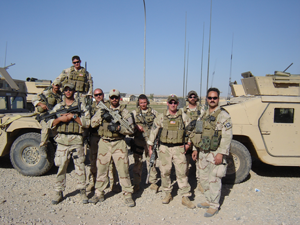SFOD-A: The A Team
Special Forces Operational Detachment A – the A Team – is the primary operational element of a Special Forces company.
An A-Team consists of 12 Special Forces Soldiers; two officers, and ten sergeants. All team members are SF qualified and cross-trained in different skills. They are also multi-lingual.
The A-Team is almost unlimited in it’s capabilities to operate in hostile or denied areas. A-Teams can infiltrate and exfiltrate their area of operations by air, land, or sea.
 An A-Team can operate for an indefinite period of time in remote locations with little or no outside support. They are truly independent, self-sustaining “detachments”.
An A-Team can operate for an indefinite period of time in remote locations with little or no outside support. They are truly independent, self-sustaining “detachments”.
A-Teams routinely train, advise and assist other U.S. and allied forces and other agencies while standing by to perform other special operations as directed by higher authorities.
All detachment members are capable of advising, assisting, and directing foreign counterparts in their function up through battalion level.
ODA “A-Team” Structure
DETACHMENT COMMANDER
(1 per “A Team”)
Rank: 0-3, Captain
First In Command. The Detachment Commander is responsible for ensuring and maintaining the operational readiness and all other aspects of the A-Team. He may command or advise an indigenous combat force up to battalion size.
DETACHMENT TECHNICIAN
(1 per “A-Team”)
Rank: W0-1 & up
He commands in the absence of the detachment commander; serves as technical and tactical authority in all aspects of Special Forces operations; supervises all staff activities; is the psychological operations (PSYOPs) and Civil Affairs authority; has cultural, regional, and linguistic abilities; manages the mid-term and long-term planning. He can recruit, organize, train, and supervise indigenous combat forces up to battalion size.
 18 Zulu – SPECIAL FORCES OPERATIONS SERGEANT
18 Zulu – SPECIAL FORCES OPERATIONS SERGEANT
(1 per “A Team”)
Team Sergeant (Rank: E-8, Master Sergeant)
The Team Sergeant is the senior enlisted man on the Team. He is responsible for overseeing all Team operations and managing all enlisted personnel on the Team. Sometimes known as the “Team Daddy”, he is usually the person who actually runs the Team. He can recruit, organize, train, and supervise indigenous combat forces up to battalion size.
18 Fox – ASSISTANT OPERATIONS SERGEANT
(1 per “A Team”)
O&I Sergeant (Rank: E-7, Sergeant First Class)
Assists the Team Sergeant in operating the Team. Plans, coordinates, and directs the A-Team’s intelligence, collection, analysis, production and dissemination. He field interrogates and processes enemy prisoners of war. He briefs and debriefs friendly patrols. He can train, advise, or lead indigenous combat forces up to company size.
18 Bravo – SPECIAL FORCES WEAPONS SERGEANT
(2 per “A Team”)
Weapons Sergeant (Rank: E-7, Sergeant First Class)
Asst. Weapons Sergeant (Rank: E-6, Staff Sergeant)
The weapons experts. Capable of firing and employing nearly every small arm and crew served weapon in the world; such as pistols, rifles, machine guns, mortars, anti-tank guns, and grenade launchers. They also train detachment members and indigenous combat forces in the use of these weapons. The two weapons sergeants employ conventional and unconventional tactics and techniques as tactical mission leaders. They are responsible for the tactical security of the A-Team. Each can train, advise, or lead indigenous combat forces up to company size.
18 Charlie – SPECIAL FORCES ENGINEER SERGEANT
(2 per “A Team”)
Engineer Sergeant (Rank: E-7, Sergeant First Class)
Asst. Engineer Sergeant (Rank: E-6, Staff Sergeant)
The demolitions experts. He can build as well as destroy almost any structure. The SF “Demo Man” is capable of constructing everything from an outhouse to a schoolhouse. A key player in any civic action mission. Each can train, advise, or lead indigenous combat forces up to company size.
18 Delta – SPECIAL FORCES MEDICAL SERGEANT
(2 per “A Team”)
Medical Sergeant (Rank: E-7, Sergeant First Class)
Asst. Medical Sergeant (Rank: E-6, Staff Sergeant)
The life-saver. Not your average “medic”. The SF medic employs the latest in field medical technology and limited surgical procedures. He is capable of managing any battlefield trauma injury, as well as administering preventative medicine. The SF Medic is in an integral part of civic action programs in bringing medical treatment to native populations. SF medics also become “paramedics” upon completion of their SF medical training. Their capabilities include: Advanced Trauma Life Support, limited surgery, dentistry, and even veterinarian procedures. Each can train, advise, or lead indigenous combat forces up to company size.
18 Echo – SPECIAL FORCES COMMUNICATIONS SERGEANT
(2 per “A Team”)
Communications Sergeant (Rank: E-7, Sergeant First Class)
Asst. Communications Sergeant (Rank: E-6, Staff Sergeant)
The “Commo Guy” – The lifeline. His responsibility is to establish and maintain communications. He employs the latest FM, multi-channel, and satellite communications devices (he also carries the heaviest rucksack on the Team). The SF Commo sergeant is an invaluable and vital part of all SF missions. Each can train, advise, or lead indigenous combat forces up to company size.












